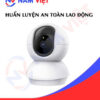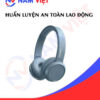Occupational Safety Training in Speaker Manufacturing
99,000 ₫
Note: The above price is calculated for one person, the price may fluctuate depending on the number of trainees participating in the course and depending on market movements. For more accurate pricing support, please refer to the quotation table or contact our consulting staff directly.
Occupational safety is an important issue in speaker manufacturing factories and needs to be addressed promptly to ensure the health and safety of workers, and to enhance the reputation of businesses. The Occupational safety training course is one of the effective solutions to raise awareness about accident prevention for workers participating in speaker manufacturing.
Table of Contents
Toggle1. Overview of Speakers
a. What are speakers?
Speakers are devices that convert electrical signals into sound, allowing users to play audio signals from devices such as computers, mobile phones, CD players, or audio amplifiers to enjoy music or watch movies. Speakers are manufactured in various sizes and designs to suit users’ needs.

b. Machinery used in speaker production
The speaker production process usually includes the following steps:
- Cutting and bending metal sheets: This process uses metal cutting and bending machines to shape and size speaker components such as frames, speaker cones, and base covers.
- Assembling the speaker driver: The components of the speaker driver are assembled and tested before being mounted onto the speaker frame.
- Assembling the speaker diaphragm: The diaphragm is mounted onto the speaker driver and positioned on the base cover.
- Assembling the speaker base: The base cover is assembled onto the speaker frame and glued for stability.
- Testing and inspection: Products are tested and inspected before packaging and shipment.
Common machinery used in speaker production includes metal cutting machines, metal bending machines, speaker driver assembly machines, drying and diaphragm pressing machines, audio testing machines, packaging machines, and transport equipment.

c. Speaker manufacturing companies in Vietnam
Many world-renowned speaker brands exist, and some of the highly regarded brands in terms of product quality and performance include:
- Bose: One of the most famous global brands, specializing in high-quality speakers with diverse models and technology.
- JBL: A well-known American speaker brand, recognized for excellent sound quality and stylish designs.
- Sony: A famous Japanese brand producing electronic products, including speakers with good audio performance.
- Harman Kardon: Known for high sound quality and elegant design.
- Klipsch: An American speaker brand with good sound quality, popular among music enthusiasts.
- Bowers & Wilkins: A renowned UK brand specializing in high-quality and diverse speaker models.
- KEF: A UK speaker brand with elegant design and excellent sound quality.
- Bang & Olufsen: A Danish speaker brand with stylish design and superior sound quality.
Other brands include Audiocenter, Pioneer, Jarguar, etc., mostly foreign brands.
d. Specific jobs in a speaker manufacturing factory
Group 1
- Executive Director, Deputy Director, and Department Heads in the speaker manufacturing factory.
Group 2
- Safety officers: manage safety within the factory, design safety procedures, supervise and ensure employees comply with safe work practices.
Group 3
- Procurement of materials and accessories: Purchasing staff acquire necessary materials such as speaker fabric, magnets, coils, speaker paper, resistors, speaker boxes, and other components.
- Cutting and processing materials: Staff cut and process materials, including speaker fabric, magnets, paper, and packaging.
- Speaker assembly: Technicians assemble components into a complete speaker, including installing magnets, coils, speaker paper, and other parts into the speaker box. Components are then assembled and packaged.
- Quality control: Quality control staff conduct tests to ensure all speaker components function correctly and are defect-free.
- Product packaging: Completed products are packaged for shipment and sale.
- Maintenance and repair: During production and after sales, maintenance staff check and repair speakers to ensure proper operation and customer satisfaction.
Group 4
- Office work, service, sales, marketing.
- Production management, quality management, human resources management, materials management, financial and accounting management.
- Product design: Product engineers create technical drawings and 3D models of speakers, determining technical details and specifications.

e. Common types of speakers on the market
There are many types of speakers on the market, including the following common types:
- Bookshelf speakers: Compact speakers often placed on shelves or desks. Usually 2-way or 3-way designs providing good sound quality at reasonable prices.
- Floor-standing speakers: Larger speakers placed on the floor, usually 3-way or 4-way, capable of producing high-quality sound.
- Soundbars: Designed to enhance TV sound. These are long and narrow, can be placed on a desk or mounted on the wall.
- Subwoofers: Specialized for reproducing low frequencies, often used with bookshelf or floor-standing speakers.
- Bluetooth speakers: Wireless speakers designed for portability and can connect to mobile devices to play music anywhere.
2. Overview of occupational safety training for speaker production
This article focuses on issues related to Group 3 because Group 3 directly participates in the production process and faces the highest occupational safety risks. For other groups, refer here.
a. What is Group 3 occupational safety training?
- Group 3 occupational safety training consists of sessions that equip workers with knowledge on preventing workplace accidents.
- The training course helps workers recognize and avoid hazards, reducing the risk of accidents during work.
REGISTER FOR OCCUPATIONAL SAFETY TRAINING SERVICE
b. Training duration
Initial safety training
- Total training time is at least 24 hours, including examination time.
- 8 hours of theory on safety and occupational hygiene policies and regulations
- 8 hours of theory on basic knowledge of occupational safety and hygiene
- 4 hours of theory on specialized training content
- 2 hours of practical exercises on specialized training content
- 2 hours of theoretical examination at the end of the course
The safety training center distributes the hours across multiple sessions depending on the workers’ schedule. Typically, there are 6 training sessions over 3 days if the company can arrange consecutive learning hours.
Periodic safety training
- Before the occupational safety card expires, workers seeking renewal must complete a periodic occupational safety training, with periodic training hours equal to at least 50% of the initial training hours.
Explanation: total periodic safety training time is at least 12 hours, including examination time. Upon completing the course and passing the test, the worker’s safety card will be renewed.
c. Training content
| No. | TRAINING CONTENT | TRAINING HOURS | |||
| Total | Including | ||||
| Theory | Practice | Exam | |||
| I | Safety and occupational hygiene policies and regulations | 8 | 8 | 0 | 0 |
| 1 | Overview of the legal documents system on occupational safety and hygiene. | 6 | 6 | ||
| 2 | System of standards and technical regulations on safety and hygiene. | 1 | 1 | ||
| 3 | Specific regulations of state management agencies on safety and hygiene when constructing, expanding, or renovating facilities for production, use, storage, and inspection of machines, equipment, materials, and substances with strict safety and hygiene requirements. | 1 | 1 | ||
| II | Basic knowledge of occupational safety and hygiene | 8 | 8 | 0 | 0 |
| 1 | Basic knowledge of hazards and harmful factors in the workplace. | 4 | 4 | ||
| 2 | Methods to improve working conditions. | 1 | 1 | ||
| 3 | Safety culture in production and business. | 1 | 1 | ||
| 4 | Rights and obligations of employers and employees; safety policies and regimes; functions and duties of safety and hygiene personnel. | 1 | 1 | ||
| 5 | Safety rules, signs, instructions, use of safety equipment and personal protective equipment; skills in first aid, accident prevention, and occupational disease prevention. | 1 | 1 | ||
| III | Specialized training content | 6 | 4 | 2 | 0 |
| Comprehensive knowledge of machines, equipment, substances generating hazardous factors; risk analysis, evaluation, management; safe working procedures with machines, equipment, and substances requiring strict occupational safety and hygiene compliance. | 6 | 4 | 2 | ||
| IV | End-of-course safety training assessment | 2 | 2 | 0 | 0 |
| Total | 24 | 22 | 2 | ||
See more training content of the 6 groups
d. Occupational safety card
After completing the occupational safety training and passing the assessment, workers will be issued an occupational safety card (commonly called Group 3 safety certificate).
The Group 3 safety card displays information such as full name, date of birth, job, and specific working environment. It also includes training duration, a red stamp, and signature confirming course completion.
According to Clause 2 of Article 24, Decree 44/2016/ND-CP, there are two cases:
- If the employer and employee have a labor contract, the employer must sign, stamp, and seal the safety card for Group 3 workers after they complete training from a certified occupational safety training unit and pass the assessment.
- If the worker is freelance or temporary, without a labor contract, the training unit must sign, stamp, and seal the safety card after the worker completes the training and passes the assessment.

3. Identifying Hazards Affecting Workers in Speaker Production
Potential hazards in the speaker production process may include:
- Risk of dust and chemical exposure: The speaker production process may use chemicals and materials that emit harmful dust such as formaldehyde, cyanide, acetone, butanone, toluene, and other chemicals. When employees inhale this harmful dust, it can cause health problems such as pneumonia, asthma, and cancer.
- Risk of noise exposure: Speaker production often involves machinery and equipment that generate noise. Noise can cause stress, insomnia, reduced work performance, and increase the likelihood of accidents due to distraction.
- Risk of occupational accidents: Employees participating in speaker production may need to use machinery and tools such as cutting machines, nail guns, grinders, welding machines, and hand tools. Improper use or lack of regular maintenance can lead to occupational accidents.
- Electrical hazards: If electrical equipment in the factory is not regularly maintained, lacks insulation, or is not waterproof, it can pose a risk of electric shock to workers during production.
- Risk of musculoskeletal injuries: Jobs in speaker production may require workers to stand or sit for long periods and repeatedly use their hands. Working in these positions can cause back pain, neck pain, and other musculoskeletal injuries.
4. Common Occupational Accidents in Speaker Production
Common occupational accidents in speaker production may include:
- Hand and finger injuries: Workers often use hand tools to attach and assemble speaker components. Continuous use of hands and fingers for extended periods can cause injuries or repetitive strain disorders.
- Eye injuries: During speaker production, workers may operate cutting or grinding tools that generate dust and debris. Without proper protective equipment, dust and debris can enter the eyes and cause injuries or eye diseases.
- Ear injuries: Noise during speaker production can cause ear damage if workers do not use protective equipment correctly.
- Back injuries: Lifting and moving speaker components can cause back injuries if proper lifting techniques are not followed.
- Machine-related injuries: Workers frequently operate large machines for speaker production. Failure to follow safety procedures during operation and maintenance can result in accidents such as crushing, cuts, or collisions.
- Electric shock: Workers deal with electrical equipment during production. Failure to comply with electrical safety rules increases the risk of electric shock.

5. Safety Measures When Participating in Speaker Production
Safety measures to be implemented in speaker production include:
- Ensuring safety during machinery and equipment operation: Machines and equipment must be regularly maintained to ensure stable and safe operation.
- Use of protective equipment: Employees should wear protective gear such as safety glasses, masks, gloves, ear protection, and safety shoes to protect eyes, hands, ears, feet, and head from materials, chemicals, and noise during production.
- Occupational safety training: New employees should be trained in production processes and safety measures, while existing employees need to update their knowledge on the latest safety procedures.
- Ensure ventilation and lighting: Speaker production factories should have proper ventilation and lighting to provide a safe and healthy working environment.
- Waste management: Factories must properly manage waste to ensure safety and minimize negative environmental impact.
- Control negative effects from machinery: Factories should control negative impacts such as vibration, noise, and high temperatures to maintain a safe working environment.
- Conduct safety inspections: Employees should regularly inspect machines and equipment to detect and address safety issues promptly.
- Ensure safety during transportation: Speakers should be transported properly to avoid accidents during handling and transport.
- Periodically conduct workplace environmental monitoring in factories, collect and analyze harmful factors to adjust and reduce hazards, thereby preventing occupational diseases.
6. Benefits of Occupational Safety Training in Speaker Production
An Toan Nam Viet provides businesses with the following benefits after completing occupational safety training courses as regulated in Decree 44/2016/ND-CP on occupational safety and hygiene:
- Workers can identify potential occupational hazards and take preventive measures to avoid accidents.
- Businesses can establish risk prevention measures in production, operation, and maintenance processes.
- Reduce costs associated with unsafe work practices.
- Uninterrupted production increases labor productivity and product quality.
- Compliance with occupational safety laws, avoiding legal risks.
- Enhances reputation and professionalism, boosting brand value for the business.
Nam Viet’s training courses are solutions to prevent external hazards, allowing individuals to avoid injuries or even fatal accidents.
REGISTER FOR OCCUPATIONAL SAFETY TRAINING SERVICE
7. Customer Feedback After Completing Speaker Production Safety Training
An Toan Nam Viet has many years of experience accompanying numerous businesses in Vietnam in general and in the southern provinces in particular. This responsibility is invaluable, which is why our Occupational Safety Training is increasingly professional. Our growth is fueled by positive feedback and suggestions from our business partners. Below are some testimonials from our clients.
Bac Nam E&C Investment & Construction Joint Stock Company
“Using An Toan Nam Viet services for the first time, I was surprised by the 24/7 support from the consulting team. Class organization was fast and convenient for our company. Thank you very much for Nam Viet’s service!”
See more customer interviews after using services from An Toan Nam Viet
8. Occupational Safety Training Capability of An Toan Nam Viet
An Toan Nam Viet is a reputable and high-quality occupational safety training center in Vietnam. Training sessions are held continuously at workshops, factories, or construction sites nationwide (all 63 provinces).
REGISTER FOR OCCUPATIONAL SAFETY TRAINING SERVICE
Occupational Safety Training License
- An Toan Nam Viet has been inspected and certified by the Department of Occupational Safety under the Ministry of Labor – Invalids and Social Affairs, confirming our qualifications to conduct occupational safety training.

Training Materials and Lectures
- Before being used in Occupational Safety Training courses, all materials are reviewed to ensure accuracy and effectiveness.
- Teaching methods of instructors follow An Toan Nam Viet standards, developed by experts in occupational safety and hygiene training to maximize knowledge absorption.
Facilities
- Controlling classroom conditions improves teaching efficiency and knowledge absorption.
- Training support facilities include spacious classrooms meeting standards for area, lighting, and equipment.
9. Nationwide Reputable Occupational Safety Training Center
At An Toan Nam Viet, we prioritize professional dedication in occupational safety training. Imparting knowledge on self-protection helps workers stay safe and contributes to the country’s development.
We meticulously prepare every detail to ensure effective training, from tools, teaching equipment, curriculum, materials, to audio and lighting.
Our instructors are experienced experts who have conducted research on identifying hazards across industries and prevention methods.
Lectures are practical, engaging, and easy for workers to understand, improving comfort and knowledge absorption. All content adheres to Decree 44/2016/ND-CP.
Workers learn preventive measures and self-protection strategies and apply them in practice.
Our Occupational Safety Training Center proudly provides professional, reliable training services with advantages:
- Competitive training costs while ensuring quality.
- Flexible schedules to fit company production needs.
- Quick certification procedures in compliance with legal regulations.
- Experienced instructors with many years in the profession.
- Classrooms controlled to enhance teaching efficiency and knowledge absorption.
- Lectures tailored to occupational safety needs of enterprises.
- An Toan Nam Viet works with dedication and professionalism to support customers promptly and accurately.

10. Additional References for Speaker Production Occupational Safety Training
- Speaker Production Occupational Safety Materials
- Occupational Safety Training Materials Set
- Occupational Safety Training Test Set
- Speaker Production Occupational Safety Training Curriculum
- Speaker Production Occupational Safety Quiz
1 review for Occupational Safety Training in Speaker Manufacturing
No comments yet















namchinh.haiphong341
Giảng viên dạy rất sinh động dễ hiểu!